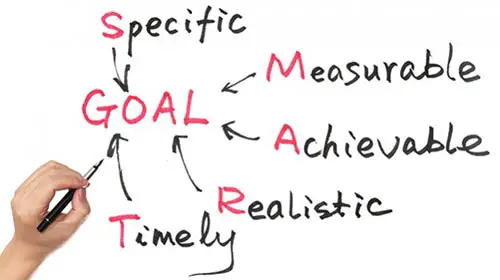Let’s take a trip down memory lane just for a moment. Think about some of the goals you’ve set in the past. Think about those you reached and those that you didn’t.
Think about the goals that slipped your mind entirely before you could even get ’em off the ground. What made the difference?

It might not be easy for you to put your finger on, but it turns out there’s quite a bit of research behind the way we set goals and whether or not we turn those dreams into reality.
It probably goes without saying that you have to do more than think about what you want. How do your turn your desire into action?
It all comes down to the battle between process-based goals versus outcome based goals. Think about it this way: in your career, you likely have strong suits that are habits.
The development of these habits in the first place is a process-based goal. You already have some knowledge and a routine that puts it into place. So, where does your outcome lie?
The outcome-based goal is the end of the journey. It’s where those habits are going to eventually (hopefully) take you.
Essentially, you can skip the whole ‘practice makes perfect’ part of the process, because you’re already “perfect.” Instead of working to get better, you can work on a concrete goal.
Does that make sense? Let’s dig a little deeper into five strategies that will help you set realistic goals and turn them into something tangible.
1. Set S.M.A.R.T. goals

SMART stands for specific, measurable, attainable, realistic and time-sensitive. Forget about picking and choosing – this tactic is all about going all the way.
If your goals don’t meet this criteria, re-write them until they do. First, creating as specific a goal as possible will give you a very clear picture or representation of exactly what it is you’re setting out to do.
For example, if you’re looking to lose weight, put a number on it! Maybe, you’d prefer to go by the way a specific article of clothing fits you. In that case, you have something measurable – literally!
Our example is a pretty common goal that we lose sight of both attainability and reality with. We set the bar high, and we get disappointed when we don’t see the progress we’d like to in a set period of time.
Be smart. We can all get as far as we are willing to push, but an attainable and realistic goal takes into account time… which leads us to our last factor.
Your goal should look like this: “In x months, I want to lose x pounds/kilos.” Don’t just say you want something, say when you want something. This gives you just enough pressure to get disciplined.
2. Take it one day at a time

Most of our goals are long-term, especially outcome-based goals. Even so, you shouldn’t underestimate what you can get done in a day. After all, that’s where the process builds and builds until it becomes the magic you’re going for.
Getting into a daily routine that is goal-friendly, productive (check out our favorite hacks for getting to work here) and ambitious is vital to making things happen, so do it!
Lay out your day so that you have space carved out to take care of what needs to be done to get you from point A to point B.
In the example of a fitness-focused goal, it’s important that you organize a few things: proper rest to perform well, proper nutrition that aligns with your goals and enough time to train for whatever your long-term fitness goal is.
Make sure these things fall into place. These are your process-based goals, those daily habits that become second-nature.
3. Be open to change

While setting a concrete, structured goal that’s pretty much set in stone, it’s important to remember that life happens. Thus, things can change. So how can you get to your end point?
One common plateau we come to when we’re chasing a bigger goal is the lack of challenge. All of a sudden, it feels like we’re not getting anywhere.
This is especially true if the process-based goals are pretty set in stone and your daily routine is just like going through the motions. While it’s great to be actively working towards something without having to hustle all day, it can be beneficial to add something to the mix that really pushes you.
On the other hand, your routine might become less conducive to getting where you want to be at some point. Maybe you’re running into the same rut over and over, even if that habit was working.
Don’t be afraid to question your process and tweak it if needed.
4. Follow your daydreams

Daydreaming is often thought of as counterproductive unlike setting goals and working towards. Think again, though – being a little fantastical in your thinking has huge benefits.
It goes without saying that your daydreams may not be attainable or realistic, which is important, but we can’t be all business all the time. Discipline is necessary, but it also has the potential for burning out, and we want to avoid that at all costs so as not to put you off from pushing forward.
Keeping in mind our need to visualize our goals, it’s okay to see that “best case scenario.” Where might you be if you exceeded your goals?
Where could you get to if you kept on this path for 12 months rather than the allotted 6 month time period? What goal could you set once you reach the one that you’re currently working towards?
Even if these thoughts seem unrealistic now, chances are, they aren’t so far off. Thinking outside of the box can help you create the life you truly want to live.
Moreover, these fantastical thoughts help you to relieve self-doubt and build up confidence. Remember – you can do anything you set your mind to!
5. Keep your cool

Again, we’re ALL for you pushing your limits. Being disciplined, hustling hard and keeping your eyes on the prize will get you to where you need to be; there’s no doubt about it. However, avoiding burnout requires a little downtime, too.
As much as it’s important to schedule your day around productive habits, efficiency and diligence, it’s nearly just as vital to schedule in a few breaks.
If your goals are overwhelming you or you need to take some time off, consider relaxation techniques like journaling and meditation. These are perfect opportunities to reflect on the reasons you feel overwhelmed in the first place.
Moreover, they offer up some perspective on how to push past frustration or setbacks and make an action plan to continue moving forward.
Without some zen in our lives, our goals would never get accomplished because we would get stuck.
What do you think? Does the difference between process-based goals and outcome-based goals make sense? Share your story about your biggest hurdles with us!
Music, mountains, dogs, travel, food and friends.

